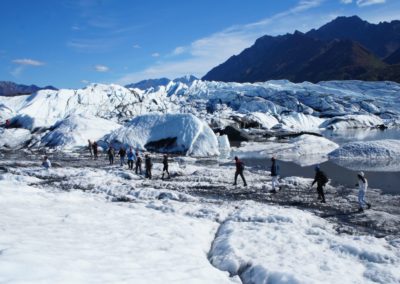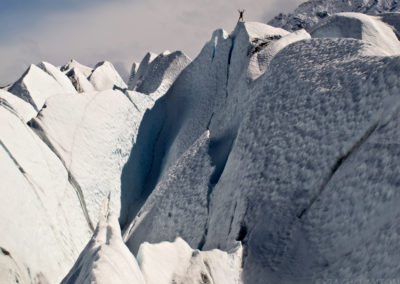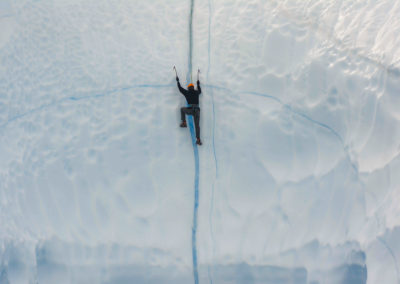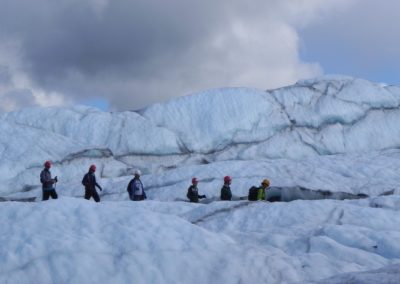Glacier TOurs
Let us show you the Alaskan ice!
For over 30 years, NOVA has been the original guide service operator of the Matanuska glacier. NOVA offers daily glacier trips ranging from 3 to 8 Hours in length, creating a perfect half or full day escape. Our most popular Glacier tour is offered three times daily. The Matanuska Glacier is where all NOVA glacier trips are based and is in a two-hour proximity of Anchorage with scenic highway drives along the beautiful Glenn highway. Avoid the crowds with a more local glacier experience!
Find A Trip
NOVA ALASKA GLACIER ADVENTURES
Our professional guides love their jobs! spending most of their time off back out on the ice. The Adventure Trek and Ice climbing guides have the most technical mountain, glacier and climbing experience on the Matanuska glacier. With standards, skills and techniques constantly being sharpened, our guides spend adequate amounts of quality time on the ice staying familiar, getting to know the glacier as it changes and evolves through-out the season making sure you see the best the glacier has to offer. Keeping tour ratios low, each tour is unique and personal with your own guides that customise your tour for your groups needs, physical ability and desire. With a 1:4 guide-to-guest ratio on Treks and Climbs and 1:10 for Tours (This can be flexible for certain groups). The Glacier Tour is relatively easy and perfect for most abilities. More adventurous folks should check out our challenging Adventure Trek or Ice Climbing tours. Larger booked days or groups will have multiple guides on a tour. Tour check-in is at our Hicks Creek office located a couple miles south of the Glacier off the Glenn highway near mile 96. Always bring your camera, jacket, and sunglasses for glacier activities. There are usually several areas to fill water bottles with pure potable glacier ice water to get a taste of delicious icy Alaska.
Adventure Level Difficulty
Glacier Tour: Easy • Adventure Trek: Moderate To Challenging • Ice Climbing: Moderate To Challenging
- NOVA is an advocate and steward for keeping wild places in Alaska wild. Please follow responsible travel and ‘leave no trace’ ethics when visiting these amazing places.
- NOVA tours operate regardless of most weather conditions, we go rain or shine in Alaska.
- Glaciers and weather can sometimes be cold in Alaska. Please, dress appropriately or bring along a raincoat with warm synthetic layers and socks for your tour comfort. Cotton layers are not preferred in cold environments or when wet.
- NOVA does not offer any tours that travel through or under ice caves in the warm summer months. Glaciers are very active in summer and caves are unsafe and should be avoided for potential cave collapse. Caves are not always present or accessible and should only be approached with caution, preferably in Winter when they are the most stable.
- Once you are traveling on the glacier restroom breaks are difficult to accommodate, please consider facilities pre-trip.
- NOVA’s Glacier tour season is June 1st through Sept 10th.
- Make it a COMBO Discount: Add a whitewater rafting trip and save 10% per person on both of your tours! This glacier tour is located in the same area of Alaska as our ‘Lionshead’ rafting tour, great for same day combos. Discounts applied at trip check-in with balance due.
GLACIER PARK Entrance fee
Matanuska Glacier Park is privately owned and charges per person every time you go through the gate; Alaska State passes do not apply. This outfit has a NO DRONE policy in place for the glacier.
- Regular entry fee at MGP gate is $45 per person.
- Teens (13-16): $25
- Adults (17+): $45
- Alaska Residents, Military and Seniors (65+): $30
Geology
The Matanuska Glacier is alive with geology. This 26 mile long alpine glacier is currently advancing as it recedes in a process known as surging. Nestled between the jagged peaks and spires of the Talkeetna and Chugach mountain ranges sits this astounding piece of ice. This natural wonder is one of the most accessible in the world by vehicle with driving access just under a mile from the main ‘Ice Falls’ area. This ice falls area at the front terminus is where the glacier terminates, subsidies and collides with harder rock deposits underground forcing the glacier’s own gravitational energy back upward, sending up vertical walls and razor thin fins of sheer ice known as ceracs. At the base of this ‘Ice Fall’ is a small lake from the melt runoff of the ice. This lake is the creation station for the mighty river that flows and drains down to the coast out the mountain valley below. There are an estimated 100,000 glaciers in Alaska, with only 616 of them named, the Matanuska is one of the grandest on the list. Glacier ice is very dense compared to common winter ice, it often gets the blue hues because of this incredible pressure by compressing out the air and oxygen making a denser make-up of the water molecules and crystallization. Water ice is blue for the same reason that large quantities of liquid water are blue. It is a result of an overtone of an oxygen–hydrogen (O−H) bond stretch in water, which absorbs light at the red end of the visible spectrum. Ice cubes in your freezer are soft and full of air and oxygen, thus making clear hollow ice that breaks easily. Blue ice, Moulins, cervasses, ridgelines, blue pools, canyons and ceracs cover the area, disappearing and reappearing as the weeks go by. This landscape transforms constantly and is filled with abundant active geology. Demonstrations of the erosion, pressure and power of this immense mass of ice are all around, from the rocky moraines to the ‘Ice Falls’. Moraines are glacial till or rock covered fields that surround the perimeter of a glacier with lateral, medial, and terminal moraines. The rock and till is scraped from the mountain walls miles back in the mountain valley and carried and deposited to the opening of the glacier valley at its terminus. The Matanuska has a terminal moraine that is easy to cross accessing the ‘Ice Falls’. Millions of tons of fill debris made of rocks, silt and till are constantly carried by the Matanuska and neighboring Kink Glacier at one point where one in the same, expanding over the Chugach mountains in a dome connected. Rivers and winds carry this debris miles down valley depositing it over the lands of the Matanuska-Susitna Borough. Like all glaciers they once reached the coastline. Receding back from the Pacific ocean near Anchorage and Cook inlet. The glacial till and sediments that remained or is still being transported today, provides amazing nutrient and mineral rich top soils. These towns of the Mat-su valley are well known farming areas with bountiful crops. With great soil and nonstop photosynthesis of the midnight sun providing long hours of light the Mat-su valley became the agricultural capital of the state all because of perpetual glacial erosion. This glacier is slowly receding as it advances by losing ice, thinning during the hot summer months. Melting gradually decreases it’s thickness top to bottom as it is exposed to the sun’s energy, compared to up valley recession or waterfront glaciers that cleave away at high rates off the terminus. Glaciers help reflect solar heat and radiation back towards the atmosphere helping cool the planet in many fashions as regulators. With the glacier being exposed to dramatic temperature changes through the warmer seasons, glacial features are always in transition, forming one day and collapsing the next. Making each tour a little different from the last. Finding and exploring these evolving features is half the fun while navigating these giants of the last ice age. This spectacular glacier is a perfect venue for guided tours with its extraordinary access.
Inherent Risks
There are inherent risks associated with glacier travel and outdoor activities that everyone must accept and understand. Variable terrain, sharp rocks, slippery ice, and changing weather are common. Some safety hazards will always exist and are beyond human control. Such as major cleaving and shifting, falling ceracs, open crevasses and draining moulins can be dangerous and deadly. Rescue in these environments and features is not only technical and difficult but in some cases not possible at all. Safety standards are in place for these reasons and must be followed. Guides manage risk by interpreting terrain and recognizing hazards that average hikers and guests are unaware of. Many traveling on the ice have a false sense of security because of the friendly inviting nature of the glacier and its moraines. Individuals traveling on the glacier without guides should possess the proper knowledge, experience, and equipment.
**All participants on all our tours must follow our guidelines, procedures and sign a waiver. Only parents or legal guardians may sign for youth minors. We do not allow infants on our tours. We do not allow pets on our tours.
Rave Reviews
Testimonials
frequently asked questions
Should I Hike, Trek or Climb?
Adventure Treks focus on traveling beyond the ‘Ice Falls’ taking the more unique route for hiking and exploring. This adventure is challenging covering multiple miles over variable terrain to reach the lesser seen features requiring some endurance and physicality.
Ice Climbing trips are a clinical learning setting. With an emphasis on basic instructions and time for climbing. A challenging trek to access the climbing walls is the main distance traveled and requires a certain level of physicality. Both Treks and Climbs take the same route as the basic ‘Glacier Tour’ for the approach to the glacier terminus.
The Glacier Tour is the easiest tour as a basic walk/hike over the moriane to the beautiful terminus ‘Ice Falls’ area and is the main highlight of the glacier, and then ventures back to the vehicle.
NOVA’s Glacier tour season is from June 1 – September 10.
WHAT IS THE GLACIER FEE?
Matanuska Glacier Park is privately owned and charges per person every time you go through the gate; Alaska State passes do not apply. This outfit has a NO DRONE policy in place for the glacier.
- Regular entry fee at MGP gate is $45 per person.
- Teens (13-16): $25
- Adults (17+): $45
- Alaska Residents, Military and Seniors (65+): $30
CAN I REQUEST A GUIDE?
Yes. If your personal favorite is available, we can certainly accommodate you and our guides do love to be requested.
CAN TRIPS BE CUSTOMIZED?
Yes, we recommend booking a private trip to do what you like, when you like.
WHAT DO I NEED TO BRING? DO YOU RENT GEAR?
We do not provide any rental gear. All necessary gear is provided free of charge for NOVA trips only.
FOR GLACIER TRIPS PLEASE BRING:
Wear long pants and always bring along your sunglasses, sunscreen, a spare warm jacket or sweater and rain layers. A small daypack for the longer trips with snacks or lunch and water, lightweight gloves and hat. Hiking boots that cover the ankles with stiff soles are recommended if you want to wear your own or use our hiking boots at no additional charge. For all glacier adventures we’ll outfit you with boots, crampons and helmet; also a trekking pole if you desire. For Treks and Ice-climbing NOVA additionally provides all ice-climbing hardware.
DO WE GO IF IT'S RAINING?
Yes. We go rain or shine, so please dress appropriately for the weather of the day. There are always tradeoffs, the Glacier has more blue color visible on grey rainy days and as for the river, well you are dressed to get wet!
DO YOU NEED EXPERIENCE TO PARTICIPATE?
No experience needed; we take lots of first-timers out on our Glacier Adventures!
DO YOU OFFER GROUP TRIPS?
NOVA welcomes groups large or small! Group rafting or glaicier trips can be the perfect activity for your corporate event or team building, bachelor/bachelorette or wedding party! NOVA offers many trips throughout the day or the evening, depending on client wishes.
HOW FAR IS IT FROM ANCHORAGE?
Approx. 2-hour drive either South or North of Anchorage, depending on trip.
SIX MILE CREEK IS SOUTH OF ANCHORAGE:
Take the Seward Highway south towards Seward. Enjoy the views of this National Scenic Byway until mile maker 57 and the Hope Road intersection. It is a well-marked junction and the Hope Road only turns one-way. Turn onto the Hope Road, travel about 100 yards and turn into the first driveway (public rest area) on the right. The NOVA crew and vehicles will be there waiting for you.
The drive is about 1 hour from Anchorage.
ALL OTHER NOVA TRIPS ARE NorthEast OF ANCHORAGE:
Check-in is at our Hicks Creek facility, mile 96 Glenn Highway (38100 West Glenn Hwy for GPS users).Take the Glenn Hwy (Hwy #1) and head north from Anchorage; you’ll be traveling on the Glenn Highway National Scenic Byway all the way to Hicks Creek. About 1 hour out Anchorage you will take the overpass to Palmer and continue on the Glenn Hwy (Hwy #1) east through Palmer then Sutton and Chickaloon; go past the old NOVA office at mile 76 in Chickaloon and drive 20 more minutes up the Hwy to Hicks Creek at mile 96 of the Glenn Hwy. Watch for the NOVA sign on left at Trailhead Rd. after crossing the Hicks Creek Bridge; take that left and follow the NOVA driveway underneath the highway bridge to the main building for check-in. The drive to Hicks Creek should take about 2 hours from Anchorage.
HOW MANY PEOPLE PER TRIP?
Treks and Climbs have a 1:4 ratio with our guide to clients per trip, Tours have a 1:10 ratio with guides to clients. Private trips have their own guides. Basic trips have mixed groups.
IS THERE TRANSPORTATION AVAILABLE?
NO, there is no public transportation out of Anchorage, a rental car is your only option.
WHEN IS THE BEST TIME TO GO?
There is plenty of Sunshine all Summer long in Alaska, so it depends more on your itinerary. Photographers seem to prefer the evening glacier hikes where the low angle of light is more dramatic. Also the ‘high-water’ of the day on Alaska’s glacier rivers like LionHead is the 7:00 PM run as glacier rivers actually crest at night; great for party runs for groups of 6 or more.




